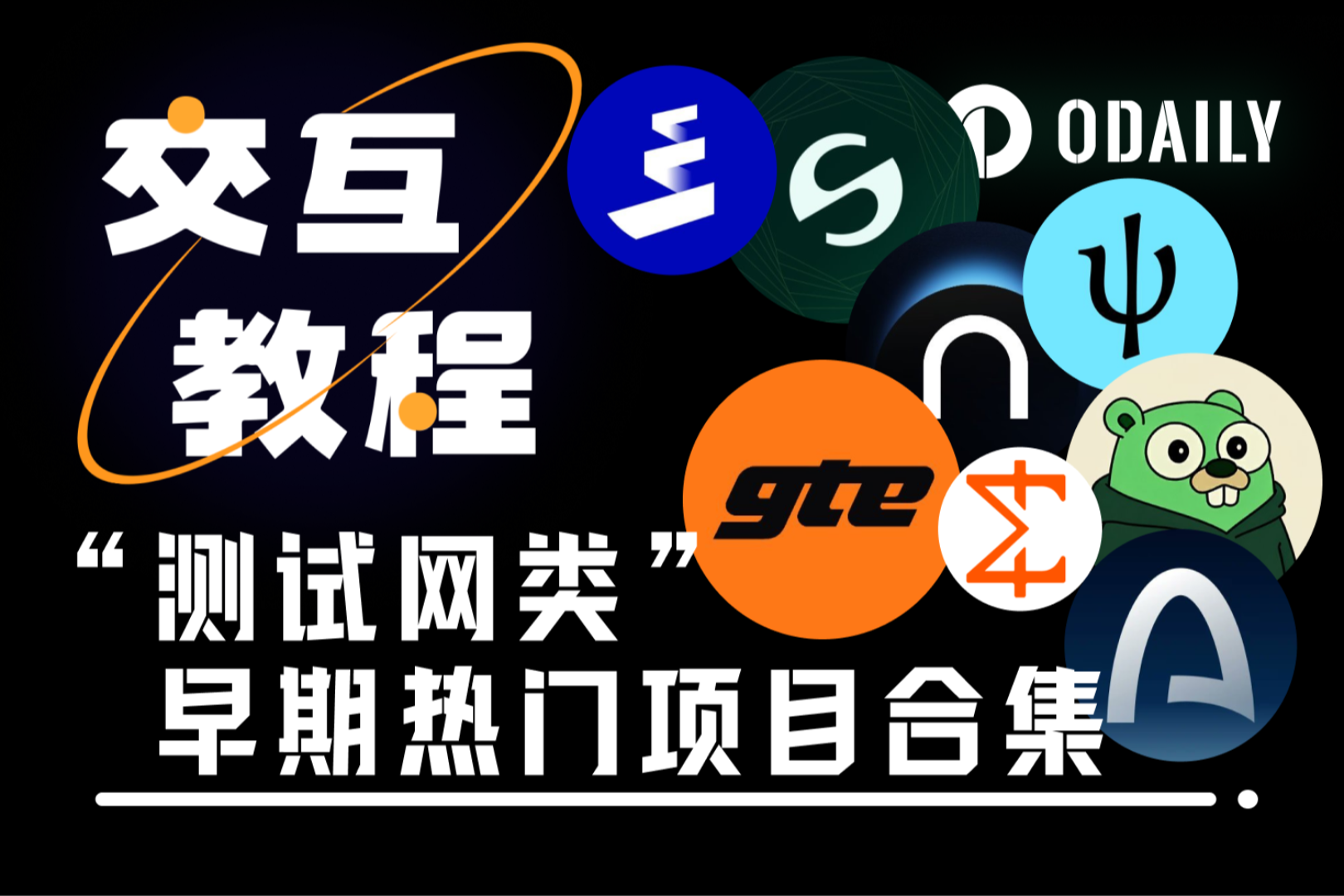Rollup Money Tree: An overview of sorter pie distribution and decentralized solutions
Original author: YBB Capital Researcher Ac_Core
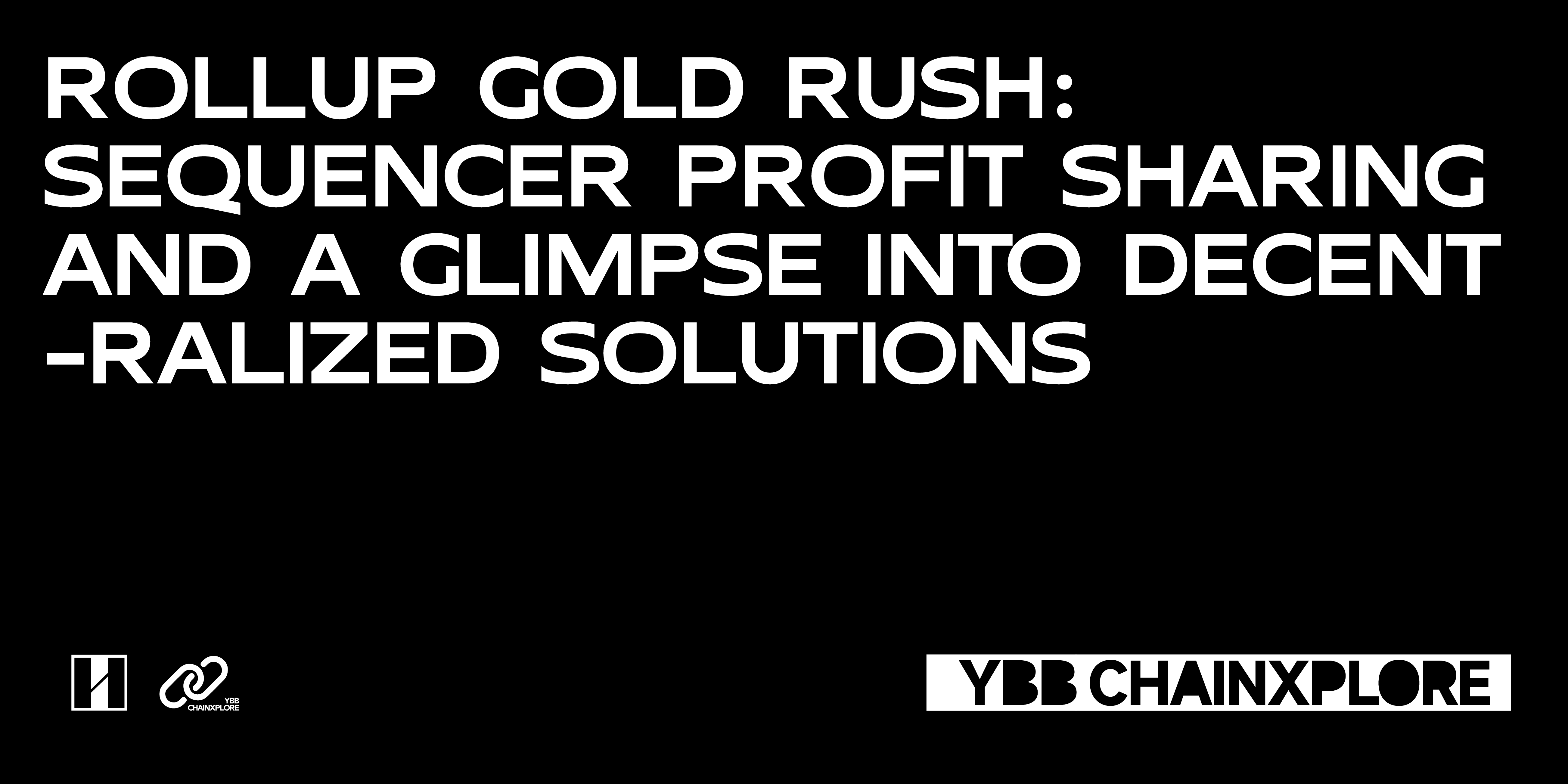
Preface
The Sequencer is an important component in the current Ethereum expansion plan Rollup. It is used to sequence transactions and perform related operations such as block creation, transaction acceptance, transaction sorting, transaction execution, and transaction data submission. With the increase in the number of Layer 2 in the Ethereum network and the prosperity of its ecosystem, Layer 2s own profit methods and centralization issues have gradually attracted everyones attention. For example, whether the more important sequencer component in Rollup can achieve decentralization and How the sorter profits are distributed. This article is only for analysis and reference, not for project publicity.
A brief introduction to Rollup Economics
Role of Rollup:
As explained by @barnabemonnot, a research scientist at the Ethereum Foundation, we can distinguish three main roles in the Rollup system: users, Rollup operators, and base layers. The main process they run is roughly: when a user conducts a transaction on L2, the Rollup operator acts as an interface between the user and the base layer, and finally publishes the data to the base layer, as shown below:
Users: send their transactions on the Layer 2 network, deploy their Layer 2 assets on Rollup for contract interaction, and flow payment fees to the Rollup operator;
Rollup operator: represents all the infrastructure required to process transactions on the L2 network, which also includes many other roles, such as: Sequencers that publish transaction batches, Executors that publish statements, and report fraud proofs Challengers (Challengers) and Validators (Validators) of computational validity proofs, the most important of which is the sequencer;
Base layer: It can also be understood as a complete node. Its purpose is to protect Rollups data protocol, to process and verify all transactions, to ensure that the Rollup status is correct and to ensure the validity of each transaction, such as discovering erroneous transactions and deleting them.
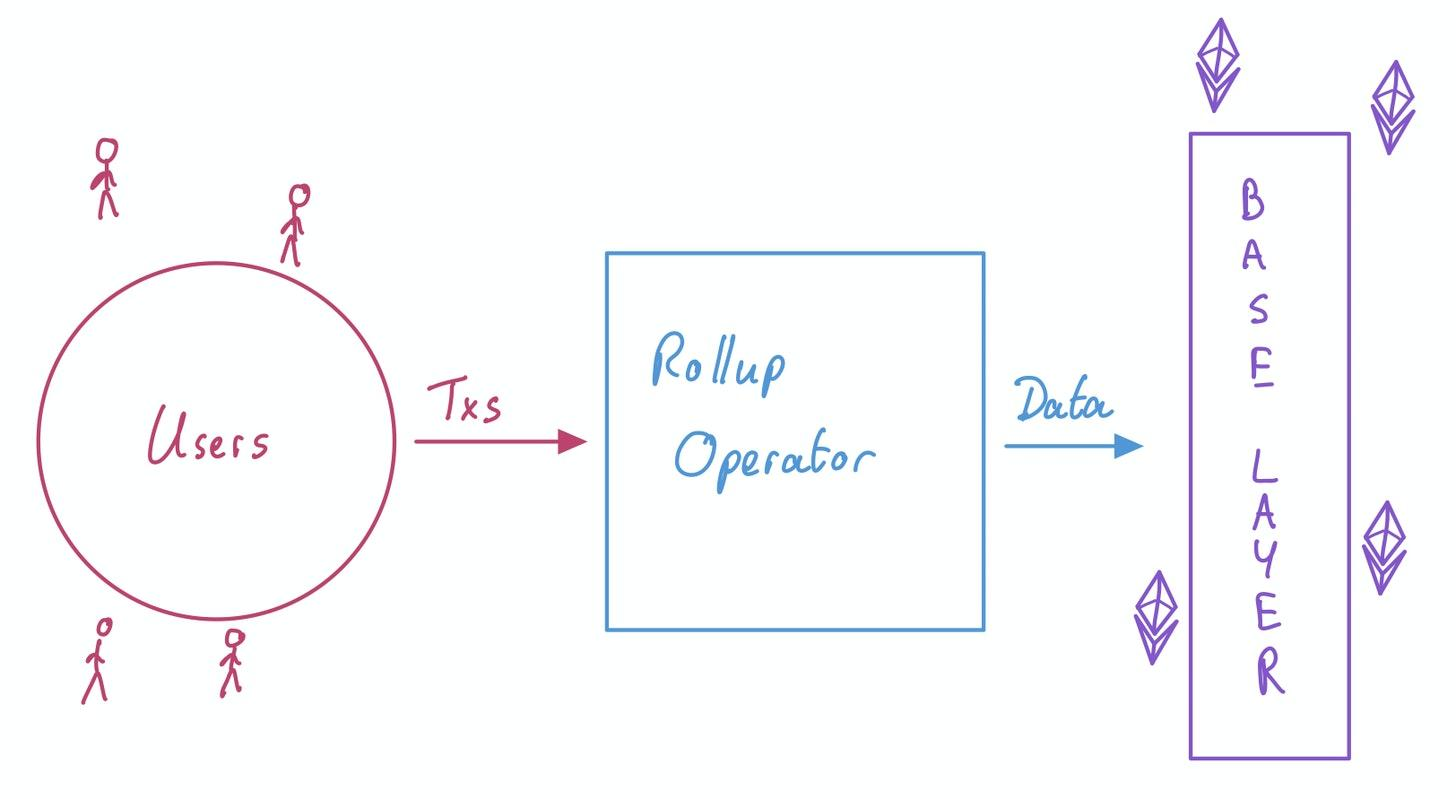
Image source: @barnabemonnot
Rollup cost:
Layer 2 carrier costs: Expenses incurred for maintaining a transaction pool, sequence batch processing, calculating state root/state difference/validity proof and other issues related to batch transaction processing, transaction verification, block generation and other issues. And because Rollup operators are now centralized, the costs incurred are borne by the protocol itself or the partners, and the transaction compression in the process needs to be settled on the base layer.
Layer 1 data availability costs: DA is the guarantee that Rollup is equivalent to the security of Ethereum. In order for Rollup to publish data on Ethereum, when an operator aggregates a large number of transaction sets, the operator needs to release the transaction set in the form of CallData. In the base layer, the DA cost contributed to Ethereum L1 accounts for the vast majority of the total cost of Rollup, and the data market price at that time is managed by EIP-1559.
Layer 2 congestion verification cost: This is a controversial impact cost. When the supply of the total Rollup block space cannot meet the existing market demand, scarce resources must be allocated. It also intuitively reflects the dynamic balance between Gas prices and network traffic.
Rollup income:
The topic comes to Rollup’s income, which mainly comes from two sources: transaction value and issuance.
transaction value
The essence of Rollup is to expand the capacity of Ethereum, speed up and reduce the pressure on Layer 1. Whether there will be MEV-related benefits in Rollup, the answer is actually no. Because Rollup itself relies on the sorter and gas expenditure to sort transactions, it does not have the concept of blocks, so it does not have a Mempool. However, nowadays private Mempools like OP Mainnet have brought MEV problems, so Rollup itself does not have Under the premise of privatizing Mempool, MEV profits will not be obtained. In essence, Rollups largest profit comes from the price difference between transaction gas.
issued
The second revenue stream is distribution. At the base layer, revenue is earned in the form of newly minted tokens for block producers of the network’s native crypto assets. To a certain extent, the infrastructure costs of block producers are offset, and more block producers will be attracted once profits are generated. We are assuming that if Rollup is able to mint its own tokens, Rollup may pay for operating expenses by issuing new tokens (but in reality the model here will be vague, and there are multiple ways to use revenue sources for Rollup costs).
Regarding the issues related to cost and income balance, we will not elaborate on it. The above is just a brief introduction. The Cancun upgrade will also affect Rollup’s profitability to a certain extent. Its core EIP-4844 (also known as Proto-DankSharding ) can be summarized in one paragraph, which is to alleviate the high DA cost problem of Ethereum Layer 1. The temporary external storage of blob has appeared, and the data content of Layer 2 transactions can be moved to a new temporary blob for storage. But it does not actually store Layer 2 transaction data in Layer 1. The advantage is that Layer 2 will have lower storage costs and faster speeds, but the current Layer 2 data black box has an uncertain impact. Still worth exploring.
Briefly describe how Rollup works:
Summary: The convolution node collects multiple transactions and creates a compressed summary, a convolution block, which contains the basic information required for transaction verification and status updates;
Verification: Rollup blocks are submitted to the main blockchain, and validator nodes verify the validity of transactions within the block and ensure that they comply with predefined rules.
Generally speaking, once the block is verified, the status of the Rollup will be updated on the chain and reflect the results of the transaction. This reduces the computational load and data storage requirements on Layer 1 through Rollup, thereby significantly improving scalability. An effective approach is to move both computation and state storage off-chain, but keep some data on-chain.
What is a sorter
The sorter is the core component of Rollups design choices. As the name suggests, it is responsible for sorting the accepted transaction pairs and the Gas prices paid, packaging and bundling the transactions into blocks and extracting fees, thereby improving the effectiveness of the transactions. orderliness and processing efficiency of the entire system. But the reality is that currently all Rollups on Ethereum are run in an isolated and centralized manner, and are managed by their respective Rollup teams. The intuitive impact of this is that Rollup providers maintain their own centralized ordering The server is used to make the entire network cheaper and faster, but this is also eating away at Rollups profits.

Source: Binance Research
Just like the cost and income part of Rollup above, its main profit comes from sorting the users Gas price difference income, while the expenditure mainly lies in the data availability cost of Layer 2 for Layer 1, and the operating expenses of the centralized operator, so The sequencer mainly collects transaction fees from the user side and pays DA fees to Ethereum. Simple understanding:
Sorter revenue = user transaction Gas spread revenue – L2 data expenditure to L1 – sorter operating expenses
Different sorting schemes for Op Rollups and Zk Rollups
Op Rollups are bundling a large number of off-chain transactions together into larger batches that are then released to the base layer. This process facilitates the distribution of a fixed fee across numerous transactions in each batch, thus reducing fees for users. While transactions are processed in batches, various compression techniques mentioned above are also used to minimize the data published to the base layer. The difference between the two is that Zk Rollups utilize cryptography to prove the validity of off-chain transactions, while Op Rollups rely on a mechanism to detect fraudulent activity to identify instances where transaction calculations are inaccurate.
A challenge period occurs after submitting a batch rollup, during which anyone can challenge the results of the convolution transaction by generating a fraud proof. After successful fraud proof, the Rollup protocol will re-execute the transaction and adjust the state of the convolution accordingly. Additionally, a successful fraud proof results in the orderers stake being slashed because the orderer included the incorrectly executed transaction in a block. In this process, if the orderer incorporates incorrectly executed transactions into the block fraud proof, the orderers interests will be damaged if successful. After the challenge period, if the rolling batch remains unverified (i.e. all transactions were executed correctly), it will be confirmed as valid and included in the base layer. Regarding the sorter issue in the implementation process, the OP is to use multiple chains but a single shared sorter.
ZK Rollups aggregate transactions into batches that are processed off-chain, reducing the amount of data that needs to be uploaded to the blockchain. Their sequencers combine the changes required to represent the entire batch of transactions into a single one, rather than transmitting each transaction individually. In order to verify that the state changes are correct, they generate validity proofs. Therefore, Zk Rollups relies on zero-knowledge valid proofs rather than fraud proofs. The sequencer collects transaction data from L2 and is responsible for submitting (depending on the specific architecture, it may also be responsible for publishing) zero-knowledge proofs to L1. If the sequencer behaves maliciously, their stakes will be reduced, which incentivizes them to issue valid blocks (or batch proofs). The prover (or orderer, if combined into one role) proves that these new states and executions are correct by generating unforgeable proofs of transaction executions.
The sequencer then submits these proofs, along with transaction data or at least state differences, to the validator contract on the Ethereum mainnet. Technically, the duties of the sorter and prover can be combined into one. But since both proof generation and transaction ordering require highly specialized skills to accomplish adequately, splitting these responsibilities prevents unnecessary centralization in convolutional designs.
In many cases, the sequencer only submits changes to L2 state to L1 while performing zero-knowledge proofs, and provides this data in the form of a verifiable hash to the validator smart contract on the Ethereum mainnet. Since Zk Rollups only need to provide proof of validity to complete the transaction, there will be no delays in transferring funds from Zk Rollups to or from the base layer. Once the proof of validity is confirmed by the Zk Rollups contract, the exit transaction will be executed.
Centralization and decentralization of sorters
Currently, all sorters in L2 are centralized, but decentralized sorters will also be particularly important in the future. From an ideological point of view, a single centralized sorter is not advisable given the assumption of trust. However, the sorter is not indispensable, it is just a design choice of Rullup, because there is currently no new solution and Rollup now uses a centralized sorting method to solve the transaction sorting problem. The actual progress of Rollup is shown in Figure L2 below. BEAT official data shown.
Centralized sorter
Advantages: It can greatly improve the transaction confirmation speed and reduce transaction costs, making the transaction experience user-friendly;
Disadvantages: Its main flaw comes from the risk of single-point downtime and monopoly. There is no need to elaborate too much on the issue of single-point downtime. Frequent Rollup downtime incidents are nothing new nowadays, and the risks brought by monopoly are not mentioned. It is obvious that the centralized sorter has undoubtedly obtained the right to sort transactions, so that it can easily maximize its own interests. Secondly, it will also bring the risk of being relatively weak against censorship.
Decentralized sorter
Advantages: Whether to use a decentralized sorter seems to have become an important criterion for measuring whether Rollup can be truly decentralized. Its advantages are self-evident. It can greatly increase the degree of decentralization and prevent operators from doing evil. It ensures the security of users assets to a large extent and effectively prevents various downtime phenomena in Rollup;
Disadvantages: The cost of improving decentralization and security is to reduce transaction speed or increase transaction costs, thus weakening the users interactive experience to a certain extent.
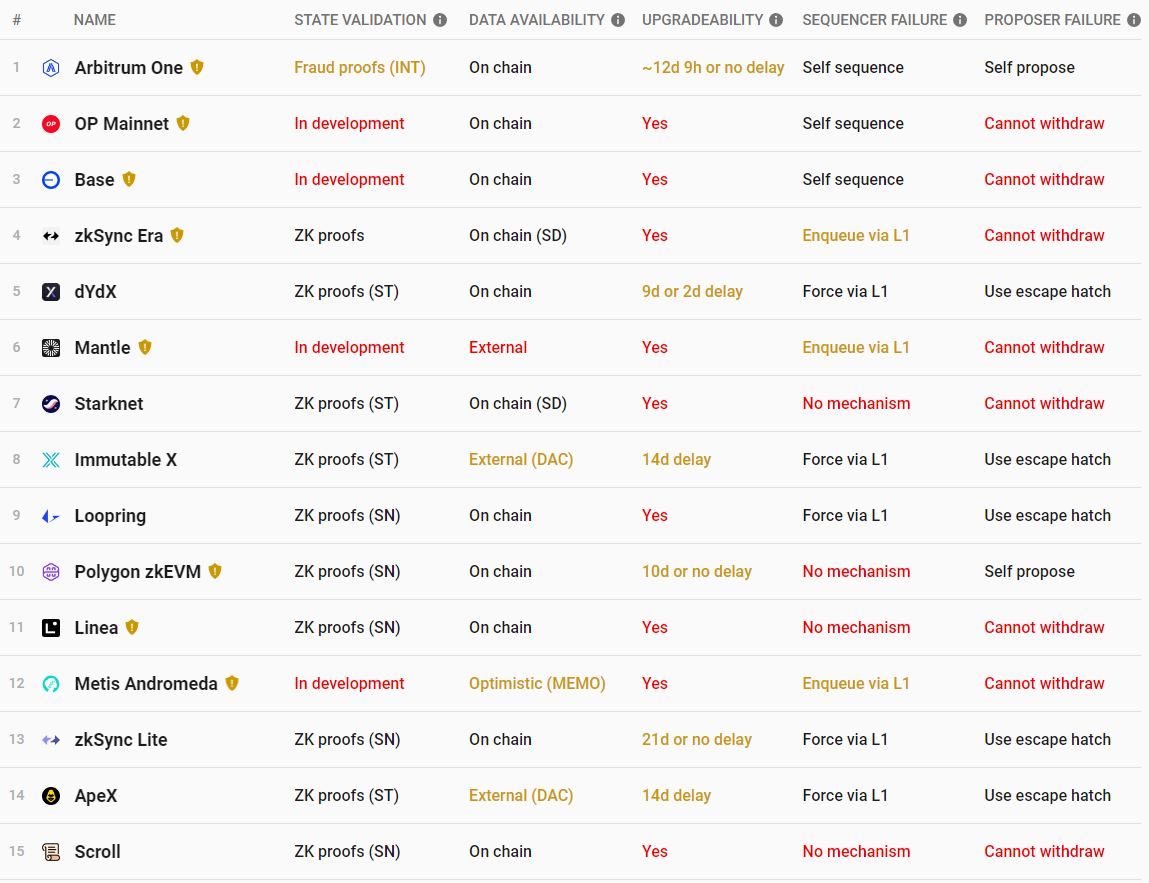
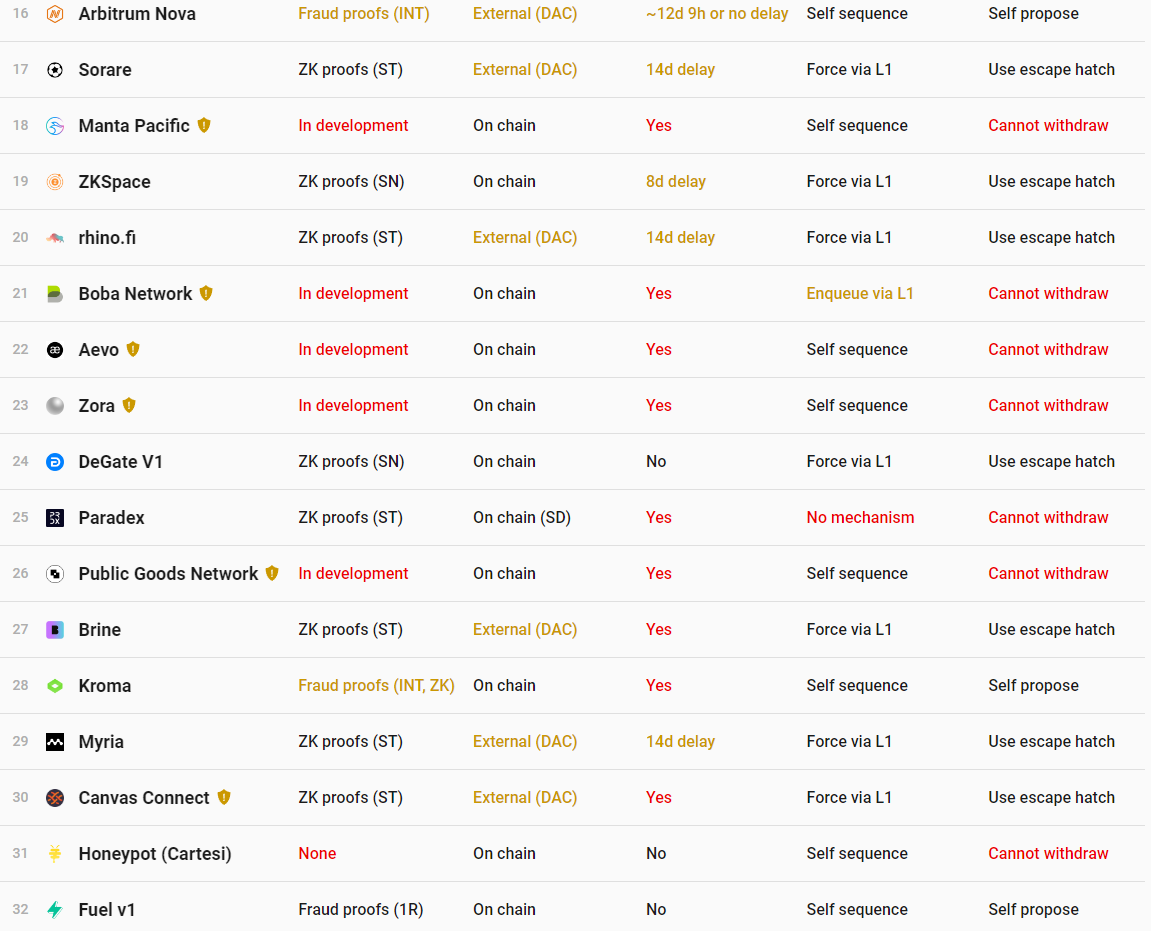
Image source: L2 BEAT
Different types of second layer
Vitalik mentioned in his recent article Different types of layer 2 s that the isomerization trend of second-layer projects will become more and more obvious in the future, and this trend will continue. For example, Arbitrum, Optimism and Scroll are traditionally used The main reasons for the recent development of the public chain represented by Kakarot and Taiko and the EVM ecosystem represented by Kakarot and Taiko are as follows:
Some projects that are currently independent layer 1 are looking to move closer to the Ethereum ecosystem, and these projects may want to gradually transition and potentially become layer 2. But because the technology is not ready yet, put everything on a Rollup for now;
Some centralized projects want to provide more security guarantees to their users and are exploring blockchain-based approaches. In many cases, these projects would have been explored in a previous era"Permissioned Consortium chains". In fact, they may only need"halfway house"level of decentralization. Furthermore, the throughput of these projects tends to be very high, so that, at least in the short term, they are not even suitable for rolling development;
Weak financial applications such as games or social applications also hope to achieve decentralization. In the case of social media, the reality is that different parts of the application need to be treated differently: rare and high-value activities such as username registration and account recovery should be rolled out, while frequent and low-value activities such as posts and polls should only be treated in a rolling manner. Low security. The risk of posts disappearing due to chain failure is affordable. The risk of account loss due to chain failure is more difficult to bear.
Although currently applications and users in Ethereum Layer 1 only need to pay a small Rollup fee in the short term, the point we want to emphasize in this chapter is whether users can smoothly and safely withdraw assets from Layer 2 to Layer 1, that is, Rollup’s “forced withdrawal” and “escape cabin” functions, see the related extension link explained by Faust [1].
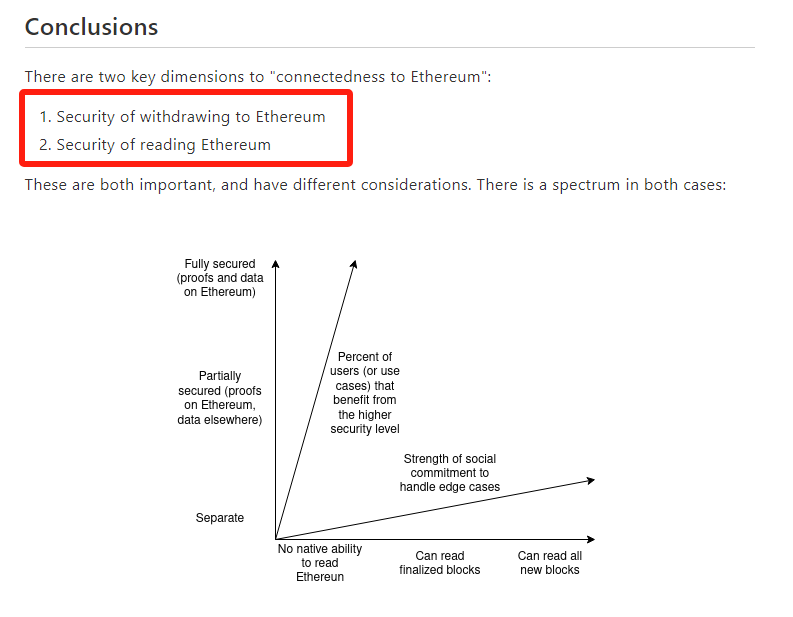
Image source: Different types of layer2s
If you have an asset that is on Layer 1, but it needs to be deposited into Layer 2 before it can be transferred to another wallet address, to what extent can we guarantee that you can get this asset back to Layer 1? For this reason, let’s use a simple chart to clarify this:
Data source: Different types of layer2s
Its worth mentioning that this is a simplified mode with many intermediate options. For example:
Somewhere between Rollup and Validium: In Validium, anyone can make on-chain payments to cover transaction fees, at which point operators will be forced to provide some data to the chain or lose their deposits.
Between Plasma and Validium: The Plasma system [2] provides convolution-like security guarantees and off-chain data availability, but it only supports a limited number of applications. A system can provide a complete EVM and provide Plasma-level assurance for users who do not use these more complex applications, and Validium-level assurance for users who use these applications.
These intermediate options can be viewed as a spectrum between convolution and rms. But what motivates an application to choose a point on the spectrum rather than a point farther left or right? There are two main factors here:
The cost of Ethereum’s native data availability will gradually decrease as the technology improves. Ethereum introduced EIP-4844 in the next hard fork Dencun [3], providing on-chain data availability of approximately 32 KB per second. Over the next few years, with the complete"On-chain data sharding"With the launch of [4], this data availability is expected to increase in stages, eventually reaching a data availability of approximately 1.3 MB per second. At the same time, improvements in data compression technology [5] will allow us to do more with the same amount of data;
The needs of the application itself: How much loss does the user have to bear compared to the high cost of an application error? Financial applications suffer greater losses from application failures; gaming and social media involve a large amount of activity per user and the value of the activity is relatively low. So for them, different security tradeoffs make sense.
One decentralized sorter is made by the Rollup project itself, and the other is implemented with the help of a third party. Using a third party to implement a decentralized sequencer can actually be called Sequencing-as-a-Service. Projects such as Espresso, SUAVE, Astria, Radius, etc. all focus on decentralized sorter solutions, and their implementation paths are different.
Decentralized sorter solution
1) Espresso: consists of five main components: 1. Sharing mechanism based on HotStuff [6] whose process needs to be determined by a two-thirds majority and is irreversible; 2. Its DA layer provides two different data Retrieve path. The first path is optimistic and fast, and the second path is more reliable, but has slower backup speed and is designed for confrontation conditions; 3. Rollup REST API: The rolling program uses this API to seamlessly integrate with Espresso Sequencer; 4. Sequencer contract : The sequencer contract is a smart contract that verifies the HotShot consensus. It can act as a light client, manage transaction order checkpoints, and oversee the equity table of the HotShot protocol; 5. Network layer: This layer is used to facilitate participation in the DA layer and HotShot Communication between consensus nodes. Overall, as shown in the figure below, when a users transaction is sent to Rollup, it uses ZK or optimistic scheme for transaction verification.
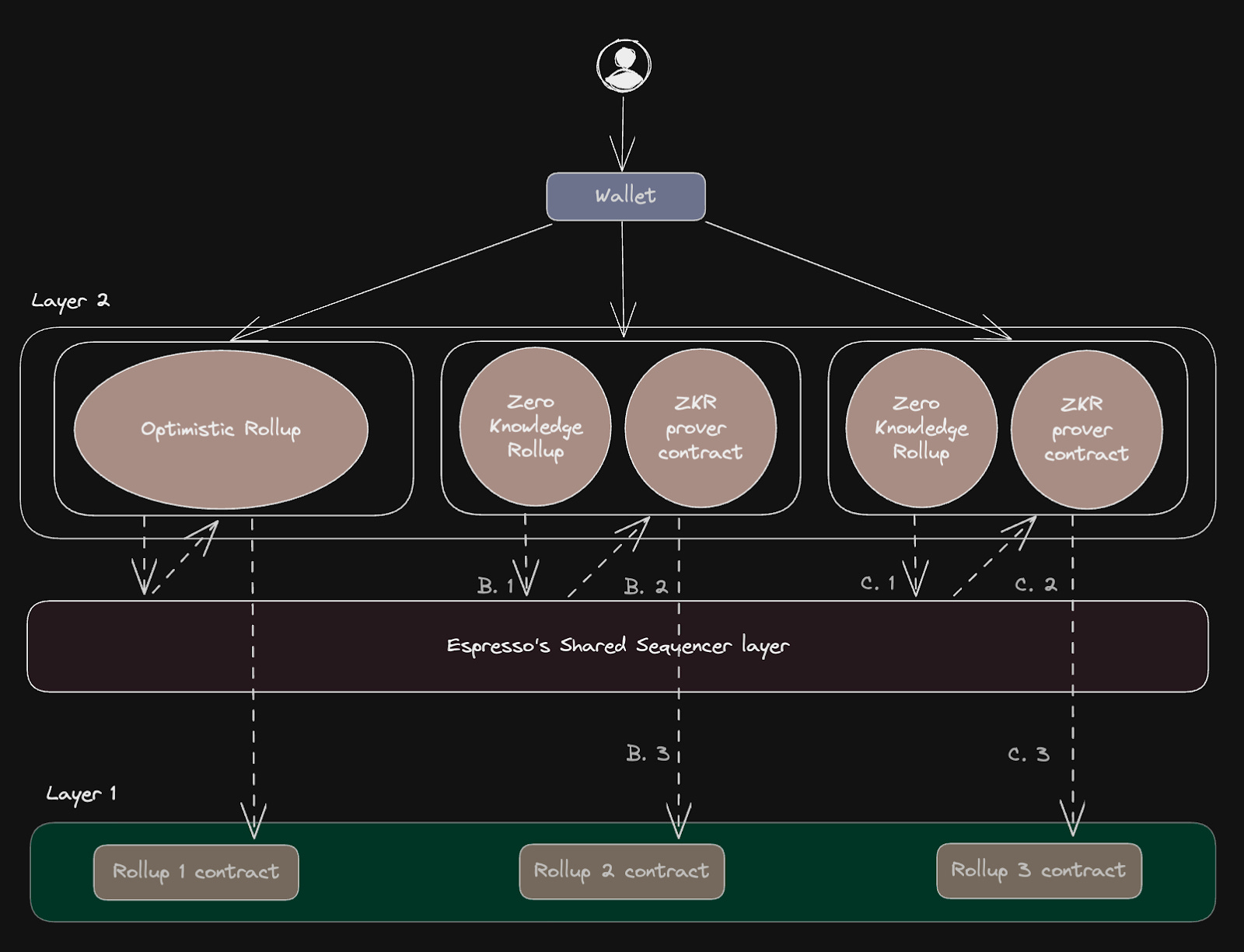
Image source: The tech: Sequencers (Overview of Espresso’s sequencing process)
2) SUAVE is an independent network layer that can share a memory pool with other block networks. It cannot be used with smart contracts on Ethereum or other public chains. Instead, the memory pool and block generation part are derived from existing public blockchains. It is separated separately from the chain to support more Layer 1 or Layer 2 networks and becomes the shared sequencer of the Rollup chain. Therefore, it also has certain advantages in transaction ordering between cross-chain MEV and different Rollups, but the risks it brings are also the same as those faced by cross-chain bridges.
3) Astria builds a shared sorter network layer to avoid the disadvantages of a centralized sorter. It relies on the Tendermint-based leader rotation mechanism to solve the scalability and centralized single point of transaction sorting. The risk of downtime due to failures. At the same time, Astiras sequencer architecture is designed to aggregate transactions from multiple Rollups, rather than generating different state roots for a single block. The resulting transactions will be arranged in sequence into cohesive The blocks are then uniformly published to the DA layer of Layer 1, thereby effectively separating transaction sequencing and execution. It is precisely because of this decoupling method that Astria can accommodate various rollups with different state transition functions.
4) The implementation mechanism of Radius is different from other solutions in that it ensures that Rollup transactions are sorted without trust by enabling encrypted Mempool and allowing multiple sorters to run simultaneously. In this way, the related risks brought by MEV are eliminated. It uses Verifiable Delay Encryption (PVDE) [7] to implement Mempools encryption, and uses zero-knowledge proof encryption to ensure trustless ordering of transactions and prevent risks related to centralized orderers. However, the price of using zero-knowledge proof to improve security is that although there is MEV protection, problems such as transaction delays may occur for users. The transaction process of Radius is as follows:
User sends transaction to sorting layer
The ordering layer orders transactions and generates a block
The composed blocks are then submitted to Rollup related programs
Rollup executes transactions in the order provided by the ordering layer
Rollup submits the executed transaction to the settlement layer DA for final confirmation
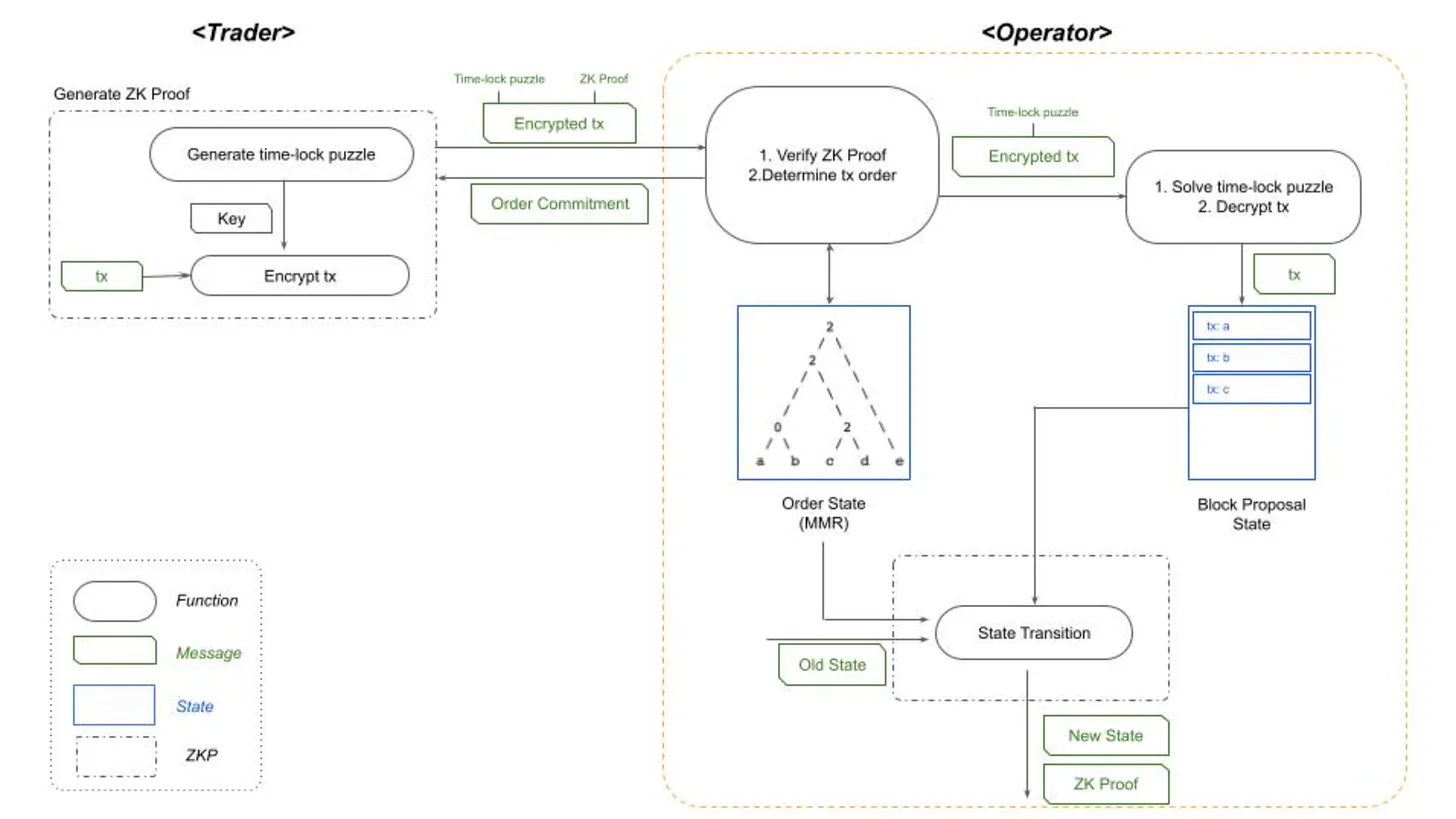
Image source: The tech: Sequencers (Radius transaction process overview)
5) Madara is the sorter used in the Layer 2 network StarkNet. It is a more flexible sorting method that can be run centrally or decentrally to customize different applications. Currently, Madara is StarkNet off-the-shelf sequencer solutions, for which research and development work is still ongoing.
Outlook
The development prospects of blockchain sequencers will be an exciting journey of change. As the blockchain ecosystem develops, sequencers will undergo major changes, moving from a centralized design to a more decentralized, efficient and adaptable design. s solution. The advancement of sorting technology is crucial for the Ethereum ecosystem to improve transaction efficiency, scalability and security.
Decentralization is the philosophical foundation of cryptocurrency. The shared sorting network solves the problems of value accumulation and income distribution through economic mechanisms. Finally, the increasingly mature modular building blocks and development framework ecosystem of the sorter will surely become a powerful catalyst for the industry in the future.
Explanatory literature:
【 1 】https://mp.weixin.qq.com/s/OEL4_-uocBy8WSU4jAeVgQ
【2】https://consensys.io/blog/ethereum-dencun-upgrade-explained-part-1
【3】https://hackmd.io/@vbuterin/sharding_proposal
【4】https://twitter.com/VitalikButerin/status/1554983955182809088
【5】https://arxiv.org/abs/1911.12095
【7】https://ethresear.ch/t/mev-resistant-zk-rollups-with-practical-vde-pvde/12677
Reference article:
【 1 】https://pansophicchad.substack.com/p/the-tech-sequencers


